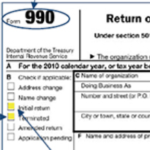By Nell Withers McCauley, CCC, SEDC
 Growing legislative, media and member scrutiny of the electric cooperative industry has placed a spotlight on the Form 990. Federally tax-exempt organizations are required to file the tax document IRS Form 990 annually. The form gives the IRS an overview of the electric cooperatives activities and governance. It also details revenues, discloses potential conflicts of interest, expenses, assets, liabilities and compensation of board members/staff. Once the electric cooperative files the Form 990, this information becomes public. Is your cooperative prepared to answer questions about the Form 990?
Growing legislative, media and member scrutiny of the electric cooperative industry has placed a spotlight on the Form 990. Federally tax-exempt organizations are required to file the tax document IRS Form 990 annually. The form gives the IRS an overview of the electric cooperatives activities and governance. It also details revenues, discloses potential conflicts of interest, expenses, assets, liabilities and compensation of board members/staff. Once the electric cooperative files the Form 990, this information becomes public. Is your cooperative prepared to answer questions about the Form 990?
Form 990 serves 2 functions for 2 different audiences:
- Tells the public about key areas of the cooperative, including compensation and program expenditures.
- Provides the IRS with information about the cooperative’s financial status and activities to document eligibility of the cooperative to qualify for tax-exemption status.
The Form 990 is useful as a public relations tool when care is taken to fill it out. It provides an opportunity for the cooperative to clarify its mission and provide details of the previous year’s accomplishments. Ensuring the Form 990 is consistent with all other communications is something to consider as a part of the cooperative’s overall communications plan.
Due to the IRS Public Disclosure and Availability Requirements, many cooperatives post the 3 most recently filed Form 990s on their website. The form 990 can be found on the IRS website, through services such as GuideStar (guidestar.org) and the IRS recently started releasing e-filed Form 990 as machine-readable, open data. The Form 990 information then becomes easily accessible to anyone researching the cooperative, including federal and state legislators. In lighting speed, all without sending an email or picking up the phone, anyone from a journalist at the Wall Street Journal, to a researcher, to a disgruntled member can aggregate this data and make judgments about the cooperative. If you researched a list of recent investigative news stories about federally tax-exempt organizations, it would reveal that most were based on a reporter’s reviews of the Form 990.
As a communicator, it is important to become familiar with key parts of the Form 990:
- Part I – Summary: Provides a snapshot of the entire cooperative by summarizing the income statement and balance sheet. It also provides a description of the mission or most significant activities.
- Part III – Statement of Program Service Accomplishments: The cooperative is asked to describe individual program service accomplishments.
- Part VI – Governance, Management, and Disclosure: This section focuses on the board of directors and asks how they provide oversight. Questions include: Is the board independent? Is there a written conflict-of-interest policy that requires disclosure of conflicts annually? Has the board reviewed the Form 990 before filing? Does the cooperative have written whistleblower, document retention and destruction policies?
- Part VII – Compensation (Section A): The cooperative must list current directors, officers, trustees and key employees.
- Schedule O – Supplemental Information to Form 990: This includes a continuation of the narrative sections and explanations of answers in other sections.
Is there an opportunity to tell your cooperative’s story on Form 990? When creating content for the Form 990, here are a few additional steps to consider:
- Involve people with communications expertise. Your cooperative could have a communicator help the accountant shape relevant portions of the document by writing clear narratives and adding content to the form.
- Be sure to edit and review. The Form 990 is as important as any critical communication piece. Offer support to ensure that the content in the Form 990 is consisely written and is free of grammatical error and typos.
- Check and edit your cooperative’s profile on GuideStar provides copies of 990s in a free online database that contains these documents from most non-profits. Many non-profits do not take advantage of an under-utilized feature that allows edits to the online profile to include important information about the cooperative at the exact moment when someone is viewing the document. This profile is free and provides an opportunity to present information on the cooperative’s mission, programs and goals.
With a bit of attention, the Form 990 can share information on the many benefits of electric cooperatives. Encourage your cooperative to utilize the communicators as a resource for completing the Form 990 and tell your story in a meaningful, mission-focused way!
Highlights of Form 990
IRS Form 990 Talking Points, Courtesy of Jerri Imgarten, CCC, The Victory Electric Cooperative Assn., Inc., Dodge City, Kan.
